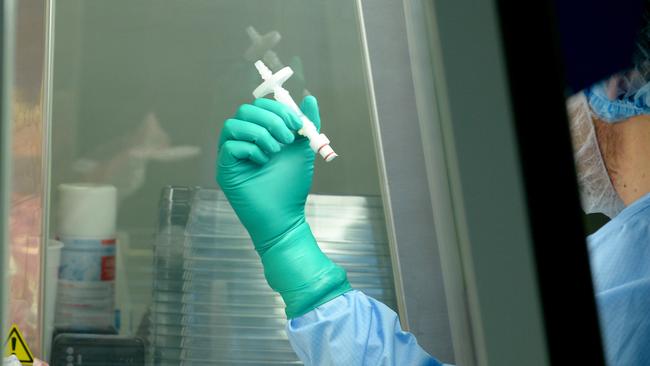Call to reduce ‘scary’ gene therapy costs
Healthcare funders have been urged to overcome the “scary” cost of emerging gene therapies.

Healthcare funders have been urged to overcome the “scary” cost of emerging gene therapies that have the potential to cure — rather than just treat — a range of difficult diseases.
Gene — or gene-modified cell — therapy has become a hot area of medical research, but with it comes the multi-billion-dollar price tag of drugs that, to date, have tackled a small patient base of rare (orphan) diseases.
But with “extraordinary” clinical results emerging, pressure is mounting on governments and private funders to subsidise the cost of such treatments which can cost millions of dollars over a patient’s lifespan.
“This is awesome science. You know it’s about as clever and as good as it gets,” former big pharma executive Rob Hetherington told the UBS Australasia conference.
The benefits are not lost on Pharmaceutical Benefits Advisory Committee member Michelle Burke, an industry appointee to the committee who advises the federal government on what drugs should be subsidised.
Ms Burke said history showed that after the initial “shock” upon global pricing being disclosed, health systems had been able to deal with high-cost therapies that delivered proven results for patients.
“We’re talking about a cure for many conditions where we weren’t even entertaining a cure,” she said.
“So I think that patient expectations will be quite different. Even if there isn’t a gene therapy available, patients will be starting to say, ‘well, why not?’”
The former Australian general manager of US biotech giant Gilead Sciences, Mr Hetherington said there was scope for gene therapies to move from orphan diseases to bigger oncology targets such as breast and prostate cancers.
“Right now (gene therapies) are confined to haematological (blood borne) cancers and relatively small inherited disorders,” he said.
“But they challenge the healthcare system in all sorts of ways in terms of funding.
“It’s probably the first time governments, policymakers and others have had to deal with true personalised medicine for a person with a very specific and unique illness, and that throws up a range of different challenges.”
First developed in the 1980s, gene therapies have gained momentum after positive clinical trial results and a slew of big-ticket acquisitions.
Seasoned local biotech executive Tim Oldham described gene therapy as “an overnight success 30 years in the making”, with between 700-800 clinical trials under way. Globally, $US10bn ($15bn) was invested in the space in 2018.
Dr Oldham said gene therapies involved manipulating faulty genes that inhibited the ability of cells to produce proteins that drove normal bodily functions.
This can involve putting a working copy of a defective gene into the patient’s cells, or shutting down the faulty gene.

Alternatively, the “gene editing” approach involves deleting the defective gene and replacing it altogether, including possibly with features the cells did not have in the first place.
“By carefully modifying viruses to remove their ability to replicate themselves, we can get them in to infect a cell once and inject the gene of interest,” he said.
“There are other ways of doing this, but the workhorse of gene therapy today is the use of viruses to deliver the new genetic payload.”
Mr Hetherington said gene therapies had produced “extraordinary” results when used as a salvage therapy for patients with advanced cancers who had failed traditional treatment.
“The efficacy was in the range of a 40 to 50 per cent cure for those patients, which is really quite extraordinary,” he said. “That’s a quantum shift from where treatments were in the past. The physicians who have had the opportunity to use these therapies speak almost in awe of just how effective these treatments are in the right patients.”
Lawrence Gozlan, the founder of life sciences investment firm Scientia Capital, said there were more than 10,000 genetic diseases that potentially could be treated.
He cited the “debilitating” spinal muscular atrophy, which affects 10,000 to 20,000 infants and is usually fatal.
US drug company AveXis ran a trial of 12 spinal muscular atrophy patients with its gene therapy candidate Zolgensma, with all of them remaining healthy after four years. “It was like a Lazarus drug,” Mr Gozlan said.
The results inspired US peer Novartis to acquire AveXis last year for $US8.7bn and in May this year the US Food & Drug Administration approved the drug for sale to the public.
“You can get these enormous valuations for companies that are developing these novel and lifesaving therapies,” Mr Gozlan said.
In another case, Bluebird Bio won European approval for its drug to treat beta thalassaemia, a genetic disease that prevents red blood cells carrying oxygen. The drug, Zynteglo, costs $US1.8m to administer against the per-patient lifetime cost of managing the disease estimated at $US20m.
“So we’re paying 10 per cent of that to cure it. It makes sense,” Mr Hetherington said.
Mr Hetherington said the cost of traditional drugs was influenced by hefty upfront research and development expenditure, rather than manufacturing expenses.
But this was flipped on its head in the case of gene therapies, which meant drug companies needed to think carefully about ongoing production costs and when and where they sold the treatments. In some cases, a dose costs more than $100,000 to make.
“The cost of these therapies is scary and it does limit the ability of companies to negotiate with governments and payers all around the world because there just simply isn’t the sort of margin that pharma companies used to see,” he said.
Ms Burke said drug companies globally were “responding in ways to be able to demonstrate value” of their new therapies. Evolving global revenue models included patients or funders paying according to the health outcomes attained, or staggering payments over several years.
-
Produced in association with UBS Australia. Read our policy on commercial content here


